Audit & Assurance Report: Financial Statement Analysis of DIPL Ltd
VerifiedAdded on 2020/03/04
|8
|2168
|34
Report
AI Summary
This report presents an audit and assurance analysis of DIPL Ltd, evaluating its financial performance from 2013 to 2015. It examines financial ratios like current, quick, gross profit, and net profit ratios, highlighting trends in liquidity, profitability, and solvency. The report identifies inherent risks, such as incorrect accounts receivable treatment and issues with a new IT system, and discusses two fraud risk factors: revenue recognition and IT technology variations. The auditor's reliance on management-provided materials and the impact of weak internal controls are also addressed. The analysis emphasizes the need for effective procedures to mitigate risks and ensure accurate financial reporting. The analysis also includes the use of analytical and substantive procedures. The report concludes with a call for improved cost control, better management of accounts receivable, and a review of inventory valuation procedures.
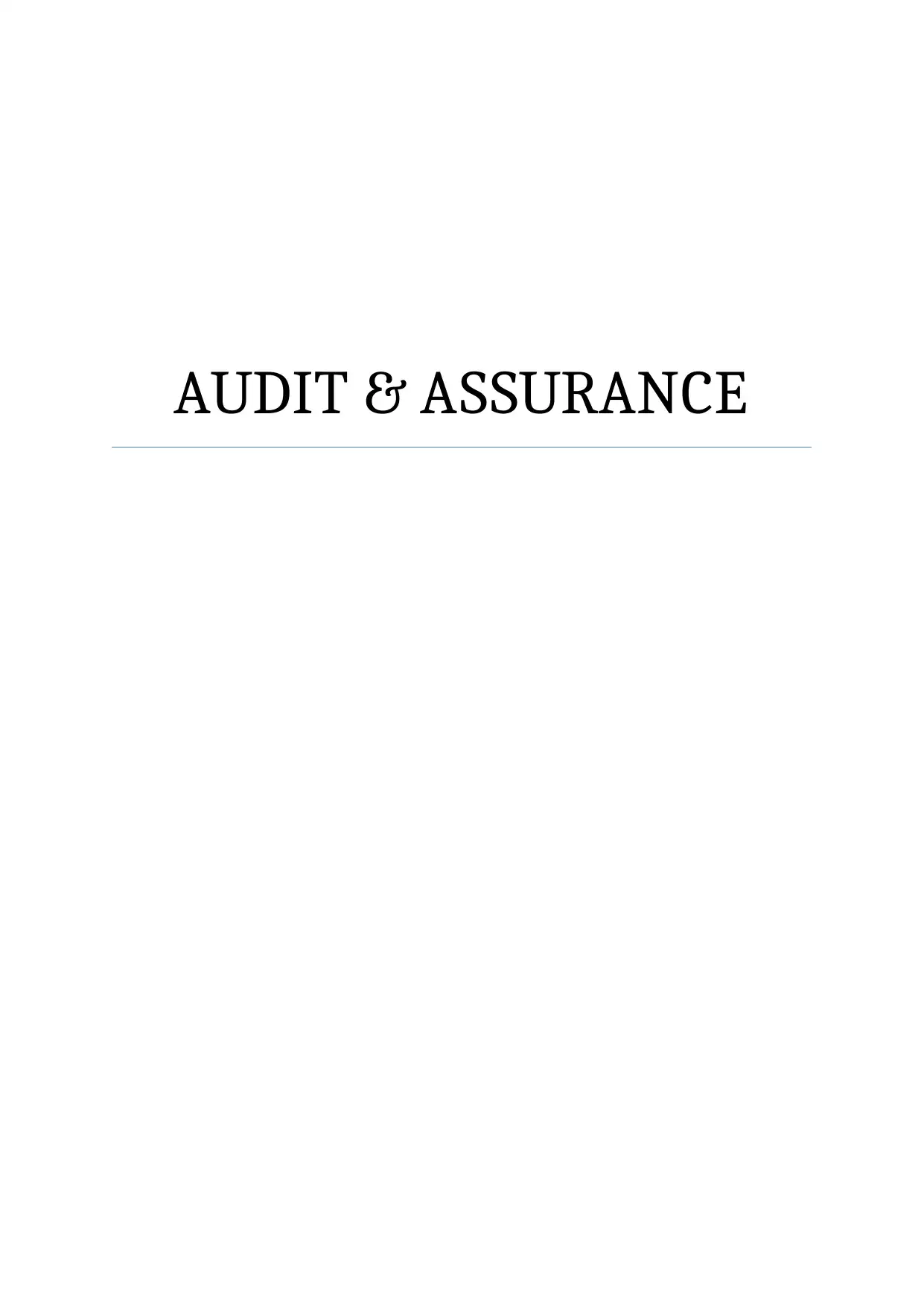
AUDIT & ASSURANCE
Paraphrase This Document
Need a fresh take? Get an instant paraphrase of this document with our AI Paraphraser
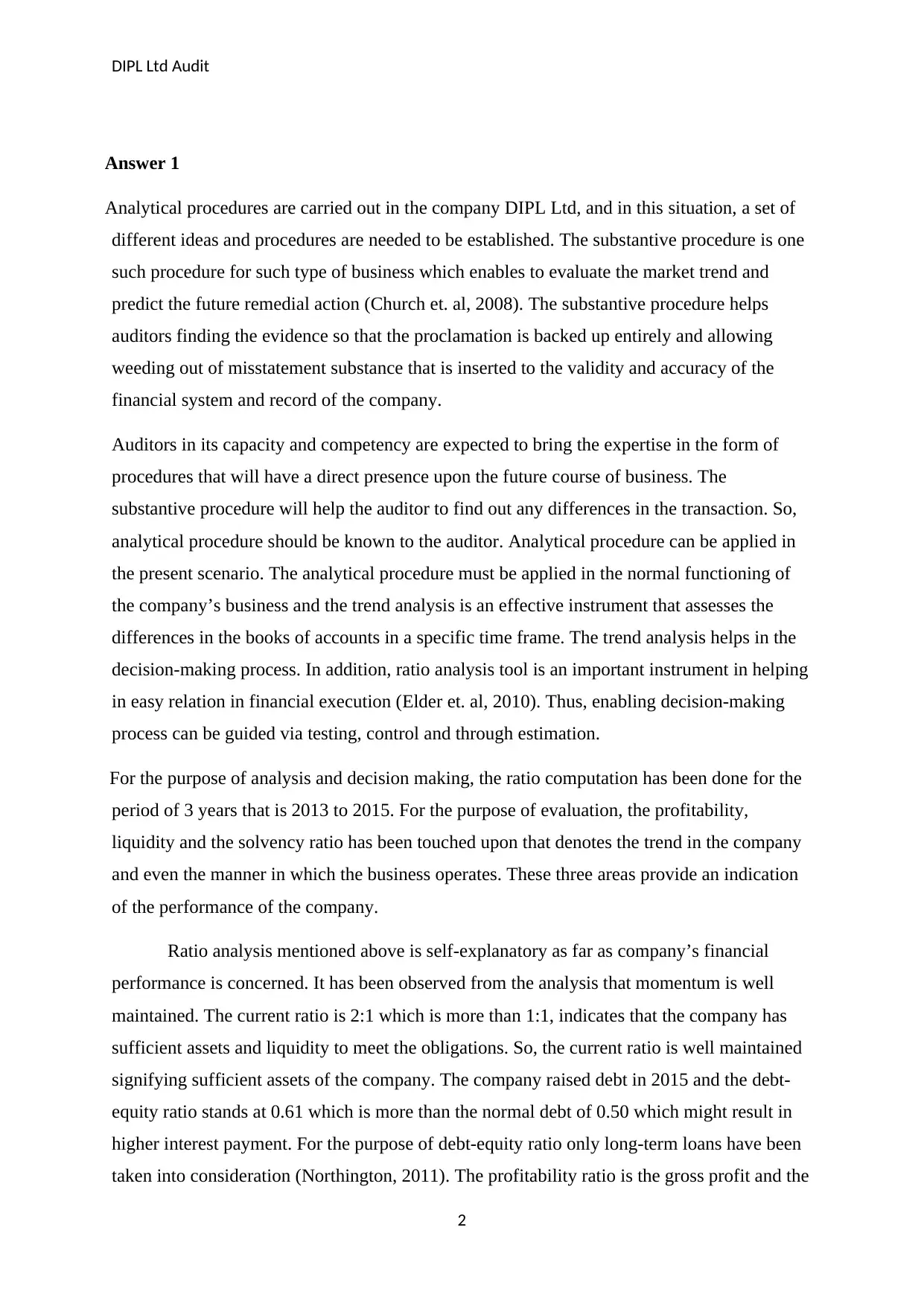
DIPL Ltd Audit
Answer 1
Analytical procedures are carried out in the company DIPL Ltd, and in this situation, a set of
different ideas and procedures are needed to be established. The substantive procedure is one
such procedure for such type of business which enables to evaluate the market trend and
predict the future remedial action (Church et. al, 2008). The substantive procedure helps
auditors finding the evidence so that the proclamation is backed up entirely and allowing
weeding out of misstatement substance that is inserted to the validity and accuracy of the
financial system and record of the company.
Auditors in its capacity and competency are expected to bring the expertise in the form of
procedures that will have a direct presence upon the future course of business. The
substantive procedure will help the auditor to find out any differences in the transaction. So,
analytical procedure should be known to the auditor. Analytical procedure can be applied in
the present scenario. The analytical procedure must be applied in the normal functioning of
the company’s business and the trend analysis is an effective instrument that assesses the
differences in the books of accounts in a specific time frame. The trend analysis helps in the
decision-making process. In addition, ratio analysis tool is an important instrument in helping
in easy relation in financial execution (Elder et. al, 2010). Thus, enabling decision-making
process can be guided via testing, control and through estimation.
For the purpose of analysis and decision making, the ratio computation has been done for the
period of 3 years that is 2013 to 2015. For the purpose of evaluation, the profitability,
liquidity and the solvency ratio has been touched upon that denotes the trend in the company
and even the manner in which the business operates. These three areas provide an indication
of the performance of the company.
Ratio analysis mentioned above is self-explanatory as far as company’s financial
performance is concerned. It has been observed from the analysis that momentum is well
maintained. The current ratio is 2:1 which is more than 1:1, indicates that the company has
sufficient assets and liquidity to meet the obligations. So, the current ratio is well maintained
signifying sufficient assets of the company. The company raised debt in 2015 and the debt-
equity ratio stands at 0.61 which is more than the normal debt of 0.50 which might result in
higher interest payment. For the purpose of debt-equity ratio only long-term loans have been
taken into consideration (Northington, 2011). The profitability ratio is the gross profit and the
2
Answer 1
Analytical procedures are carried out in the company DIPL Ltd, and in this situation, a set of
different ideas and procedures are needed to be established. The substantive procedure is one
such procedure for such type of business which enables to evaluate the market trend and
predict the future remedial action (Church et. al, 2008). The substantive procedure helps
auditors finding the evidence so that the proclamation is backed up entirely and allowing
weeding out of misstatement substance that is inserted to the validity and accuracy of the
financial system and record of the company.
Auditors in its capacity and competency are expected to bring the expertise in the form of
procedures that will have a direct presence upon the future course of business. The
substantive procedure will help the auditor to find out any differences in the transaction. So,
analytical procedure should be known to the auditor. Analytical procedure can be applied in
the present scenario. The analytical procedure must be applied in the normal functioning of
the company’s business and the trend analysis is an effective instrument that assesses the
differences in the books of accounts in a specific time frame. The trend analysis helps in the
decision-making process. In addition, ratio analysis tool is an important instrument in helping
in easy relation in financial execution (Elder et. al, 2010). Thus, enabling decision-making
process can be guided via testing, control and through estimation.
For the purpose of analysis and decision making, the ratio computation has been done for the
period of 3 years that is 2013 to 2015. For the purpose of evaluation, the profitability,
liquidity and the solvency ratio has been touched upon that denotes the trend in the company
and even the manner in which the business operates. These three areas provide an indication
of the performance of the company.
Ratio analysis mentioned above is self-explanatory as far as company’s financial
performance is concerned. It has been observed from the analysis that momentum is well
maintained. The current ratio is 2:1 which is more than 1:1, indicates that the company has
sufficient assets and liquidity to meet the obligations. So, the current ratio is well maintained
signifying sufficient assets of the company. The company raised debt in 2015 and the debt-
equity ratio stands at 0.61 which is more than the normal debt of 0.50 which might result in
higher interest payment. For the purpose of debt-equity ratio only long-term loans have been
taken into consideration (Northington, 2011). The profitability ratio is the gross profit and the
2
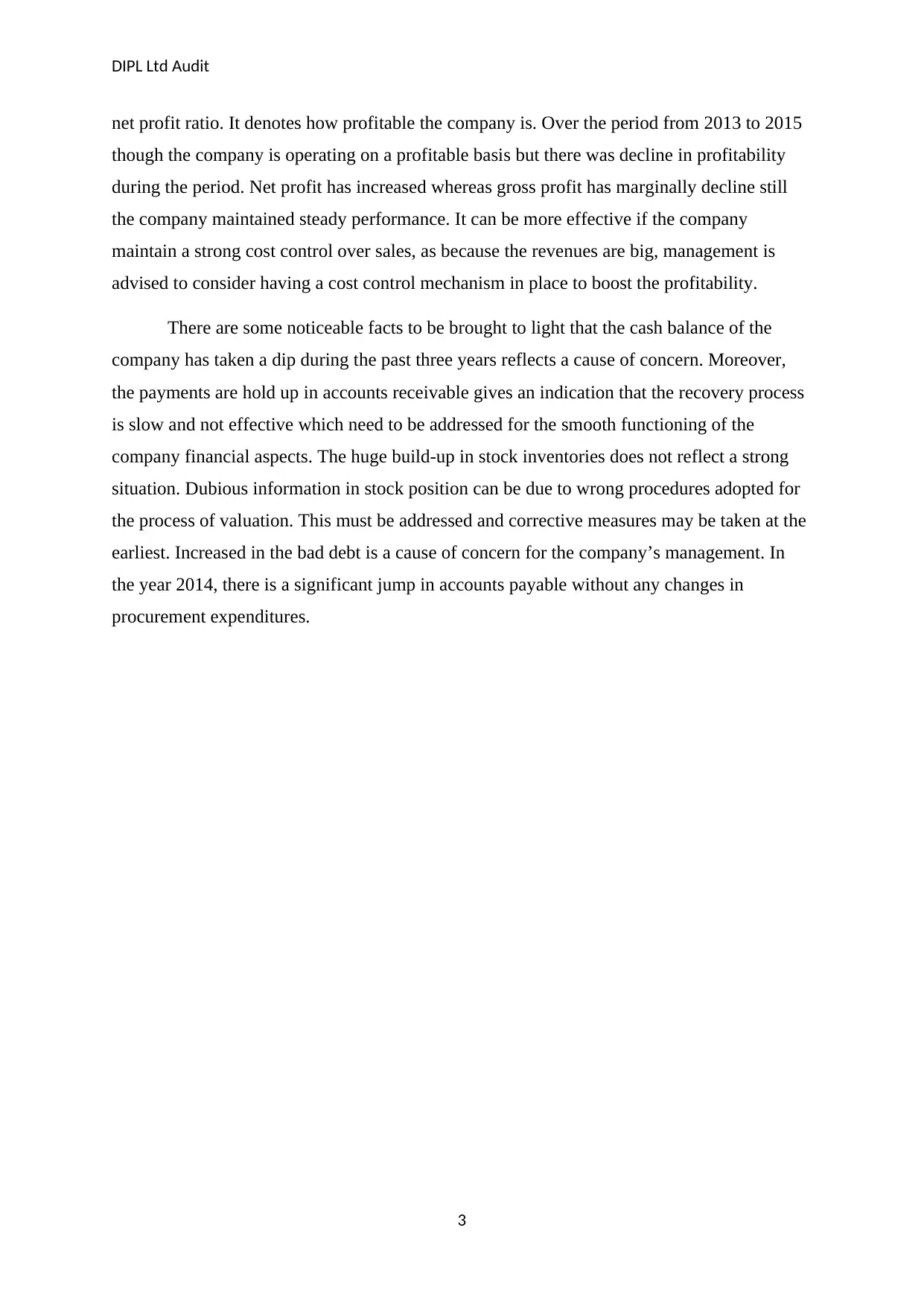
DIPL Ltd Audit
net profit ratio. It denotes how profitable the company is. Over the period from 2013 to 2015
though the company is operating on a profitable basis but there was decline in profitability
during the period. Net profit has increased whereas gross profit has marginally decline still
the company maintained steady performance. It can be more effective if the company
maintain a strong cost control over sales, as because the revenues are big, management is
advised to consider having a cost control mechanism in place to boost the profitability.
There are some noticeable facts to be brought to light that the cash balance of the
company has taken a dip during the past three years reflects a cause of concern. Moreover,
the payments are hold up in accounts receivable gives an indication that the recovery process
is slow and not effective which need to be addressed for the smooth functioning of the
company financial aspects. The huge build-up in stock inventories does not reflect a strong
situation. Dubious information in stock position can be due to wrong procedures adopted for
the process of valuation. This must be addressed and corrective measures may be taken at the
earliest. Increased in the bad debt is a cause of concern for the company’s management. In
the year 2014, there is a significant jump in accounts payable without any changes in
procurement expenditures.
3
net profit ratio. It denotes how profitable the company is. Over the period from 2013 to 2015
though the company is operating on a profitable basis but there was decline in profitability
during the period. Net profit has increased whereas gross profit has marginally decline still
the company maintained steady performance. It can be more effective if the company
maintain a strong cost control over sales, as because the revenues are big, management is
advised to consider having a cost control mechanism in place to boost the profitability.
There are some noticeable facts to be brought to light that the cash balance of the
company has taken a dip during the past three years reflects a cause of concern. Moreover,
the payments are hold up in accounts receivable gives an indication that the recovery process
is slow and not effective which need to be addressed for the smooth functioning of the
company financial aspects. The huge build-up in stock inventories does not reflect a strong
situation. Dubious information in stock position can be due to wrong procedures adopted for
the process of valuation. This must be addressed and corrective measures may be taken at the
earliest. Increased in the bad debt is a cause of concern for the company’s management. In
the year 2014, there is a significant jump in accounts payable without any changes in
procurement expenditures.
3
⊘ This is a preview!⊘
Do you want full access?
Subscribe today to unlock all pages.

Trusted by 1+ million students worldwide
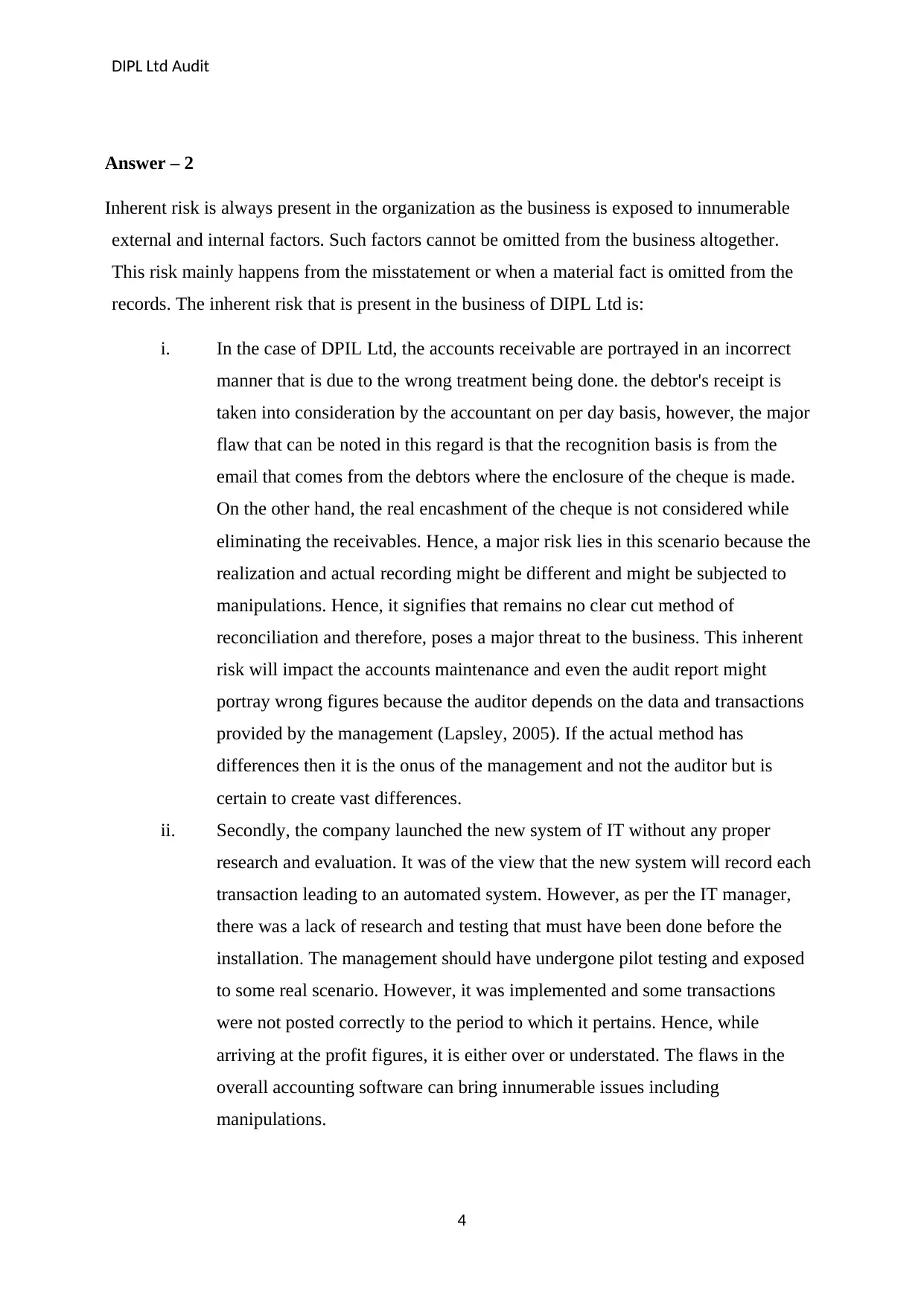
DIPL Ltd Audit
Answer – 2
Inherent risk is always present in the organization as the business is exposed to innumerable
external and internal factors. Such factors cannot be omitted from the business altogether.
This risk mainly happens from the misstatement or when a material fact is omitted from the
records. The inherent risk that is present in the business of DIPL Ltd is:
i. In the case of DPIL Ltd, the accounts receivable are portrayed in an incorrect
manner that is due to the wrong treatment being done. the debtor's receipt is
taken into consideration by the accountant on per day basis, however, the major
flaw that can be noted in this regard is that the recognition basis is from the
email that comes from the debtors where the enclosure of the cheque is made.
On the other hand, the real encashment of the cheque is not considered while
eliminating the receivables. Hence, a major risk lies in this scenario because the
realization and actual recording might be different and might be subjected to
manipulations. Hence, it signifies that remains no clear cut method of
reconciliation and therefore, poses a major threat to the business. This inherent
risk will impact the accounts maintenance and even the audit report might
portray wrong figures because the auditor depends on the data and transactions
provided by the management (Lapsley, 2005). If the actual method has
differences then it is the onus of the management and not the auditor but is
certain to create vast differences.
ii. Secondly, the company launched the new system of IT without any proper
research and evaluation. It was of the view that the new system will record each
transaction leading to an automated system. However, as per the IT manager,
there was a lack of research and testing that must have been done before the
installation. The management should have undergone pilot testing and exposed
to some real scenario. However, it was implemented and some transactions
were not posted correctly to the period to which it pertains. Hence, while
arriving at the profit figures, it is either over or understated. The flaws in the
overall accounting software can bring innumerable issues including
manipulations.
4
Answer – 2
Inherent risk is always present in the organization as the business is exposed to innumerable
external and internal factors. Such factors cannot be omitted from the business altogether.
This risk mainly happens from the misstatement or when a material fact is omitted from the
records. The inherent risk that is present in the business of DIPL Ltd is:
i. In the case of DPIL Ltd, the accounts receivable are portrayed in an incorrect
manner that is due to the wrong treatment being done. the debtor's receipt is
taken into consideration by the accountant on per day basis, however, the major
flaw that can be noted in this regard is that the recognition basis is from the
email that comes from the debtors where the enclosure of the cheque is made.
On the other hand, the real encashment of the cheque is not considered while
eliminating the receivables. Hence, a major risk lies in this scenario because the
realization and actual recording might be different and might be subjected to
manipulations. Hence, it signifies that remains no clear cut method of
reconciliation and therefore, poses a major threat to the business. This inherent
risk will impact the accounts maintenance and even the audit report might
portray wrong figures because the auditor depends on the data and transactions
provided by the management (Lapsley, 2005). If the actual method has
differences then it is the onus of the management and not the auditor but is
certain to create vast differences.
ii. Secondly, the company launched the new system of IT without any proper
research and evaluation. It was of the view that the new system will record each
transaction leading to an automated system. However, as per the IT manager,
there was a lack of research and testing that must have been done before the
installation. The management should have undergone pilot testing and exposed
to some real scenario. However, it was implemented and some transactions
were not posted correctly to the period to which it pertains. Hence, while
arriving at the profit figures, it is either over or understated. The flaws in the
overall accounting software can bring innumerable issues including
manipulations.
4
Paraphrase This Document
Need a fresh take? Get an instant paraphrase of this document with our AI Paraphraser
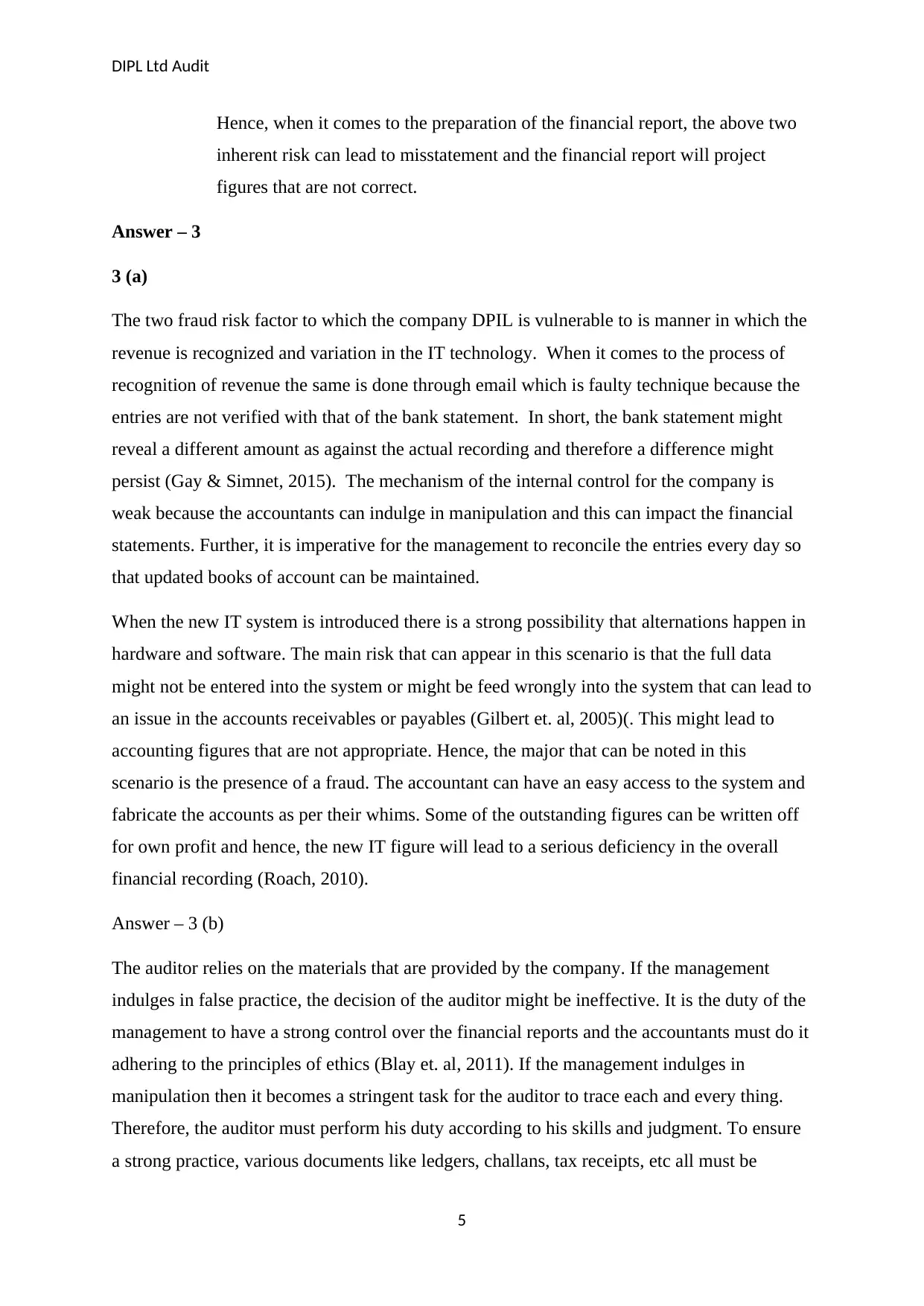
DIPL Ltd Audit
Hence, when it comes to the preparation of the financial report, the above two
inherent risk can lead to misstatement and the financial report will project
figures that are not correct.
Answer – 3
3 (a)
The two fraud risk factor to which the company DPIL is vulnerable to is manner in which the
revenue is recognized and variation in the IT technology. When it comes to the process of
recognition of revenue the same is done through email which is faulty technique because the
entries are not verified with that of the bank statement. In short, the bank statement might
reveal a different amount as against the actual recording and therefore a difference might
persist (Gay & Simnet, 2015). The mechanism of the internal control for the company is
weak because the accountants can indulge in manipulation and this can impact the financial
statements. Further, it is imperative for the management to reconcile the entries every day so
that updated books of account can be maintained.
When the new IT system is introduced there is a strong possibility that alternations happen in
hardware and software. The main risk that can appear in this scenario is that the full data
might not be entered into the system or might be feed wrongly into the system that can lead to
an issue in the accounts receivables or payables (Gilbert et. al, 2005)(. This might lead to
accounting figures that are not appropriate. Hence, the major that can be noted in this
scenario is the presence of a fraud. The accountant can have an easy access to the system and
fabricate the accounts as per their whims. Some of the outstanding figures can be written off
for own profit and hence, the new IT figure will lead to a serious deficiency in the overall
financial recording (Roach, 2010).
Answer – 3 (b)
The auditor relies on the materials that are provided by the company. If the management
indulges in false practice, the decision of the auditor might be ineffective. It is the duty of the
management to have a strong control over the financial reports and the accountants must do it
adhering to the principles of ethics (Blay et. al, 2011). If the management indulges in
manipulation then it becomes a stringent task for the auditor to trace each and every thing.
Therefore, the auditor must perform his duty according to his skills and judgment. To ensure
a strong practice, various documents like ledgers, challans, tax receipts, etc all must be
5
Hence, when it comes to the preparation of the financial report, the above two
inherent risk can lead to misstatement and the financial report will project
figures that are not correct.
Answer – 3
3 (a)
The two fraud risk factor to which the company DPIL is vulnerable to is manner in which the
revenue is recognized and variation in the IT technology. When it comes to the process of
recognition of revenue the same is done through email which is faulty technique because the
entries are not verified with that of the bank statement. In short, the bank statement might
reveal a different amount as against the actual recording and therefore a difference might
persist (Gay & Simnet, 2015). The mechanism of the internal control for the company is
weak because the accountants can indulge in manipulation and this can impact the financial
statements. Further, it is imperative for the management to reconcile the entries every day so
that updated books of account can be maintained.
When the new IT system is introduced there is a strong possibility that alternations happen in
hardware and software. The main risk that can appear in this scenario is that the full data
might not be entered into the system or might be feed wrongly into the system that can lead to
an issue in the accounts receivables or payables (Gilbert et. al, 2005)(. This might lead to
accounting figures that are not appropriate. Hence, the major that can be noted in this
scenario is the presence of a fraud. The accountant can have an easy access to the system and
fabricate the accounts as per their whims. Some of the outstanding figures can be written off
for own profit and hence, the new IT figure will lead to a serious deficiency in the overall
financial recording (Roach, 2010).
Answer – 3 (b)
The auditor relies on the materials that are provided by the company. If the management
indulges in false practice, the decision of the auditor might be ineffective. It is the duty of the
management to have a strong control over the financial reports and the accountants must do it
adhering to the principles of ethics (Blay et. al, 2011). If the management indulges in
manipulation then it becomes a stringent task for the auditor to trace each and every thing.
Therefore, the auditor must perform his duty according to his skills and judgment. To ensure
a strong practice, various documents like ledgers, challans, tax receipts, etc all must be
5
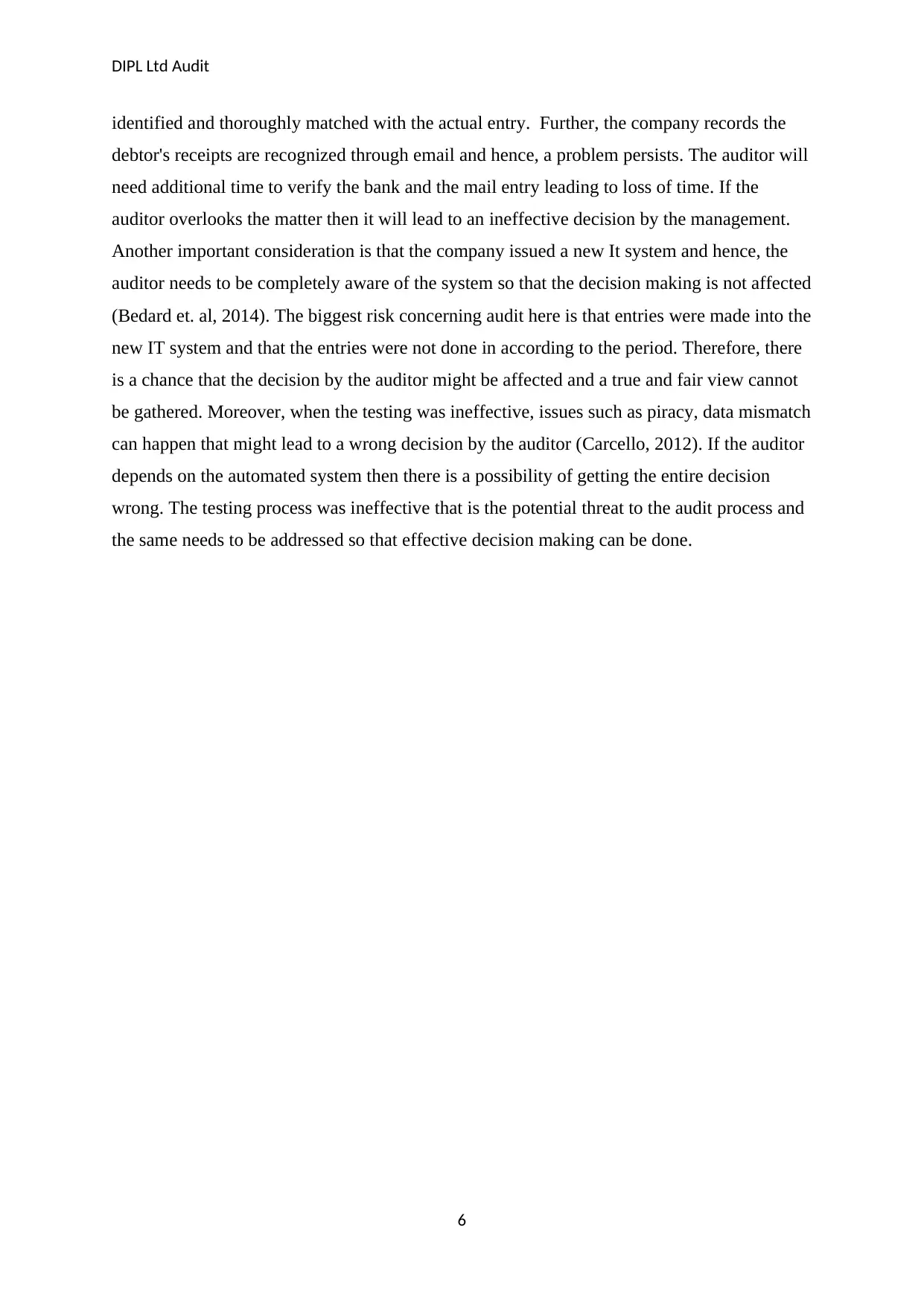
DIPL Ltd Audit
identified and thoroughly matched with the actual entry. Further, the company records the
debtor's receipts are recognized through email and hence, a problem persists. The auditor will
need additional time to verify the bank and the mail entry leading to loss of time. If the
auditor overlooks the matter then it will lead to an ineffective decision by the management.
Another important consideration is that the company issued a new It system and hence, the
auditor needs to be completely aware of the system so that the decision making is not affected
(Bedard et. al, 2014). The biggest risk concerning audit here is that entries were made into the
new IT system and that the entries were not done in according to the period. Therefore, there
is a chance that the decision by the auditor might be affected and a true and fair view cannot
be gathered. Moreover, when the testing was ineffective, issues such as piracy, data mismatch
can happen that might lead to a wrong decision by the auditor (Carcello, 2012). If the auditor
depends on the automated system then there is a possibility of getting the entire decision
wrong. The testing process was ineffective that is the potential threat to the audit process and
the same needs to be addressed so that effective decision making can be done.
6
identified and thoroughly matched with the actual entry. Further, the company records the
debtor's receipts are recognized through email and hence, a problem persists. The auditor will
need additional time to verify the bank and the mail entry leading to loss of time. If the
auditor overlooks the matter then it will lead to an ineffective decision by the management.
Another important consideration is that the company issued a new It system and hence, the
auditor needs to be completely aware of the system so that the decision making is not affected
(Bedard et. al, 2014). The biggest risk concerning audit here is that entries were made into the
new IT system and that the entries were not done in according to the period. Therefore, there
is a chance that the decision by the auditor might be affected and a true and fair view cannot
be gathered. Moreover, when the testing was ineffective, issues such as piracy, data mismatch
can happen that might lead to a wrong decision by the auditor (Carcello, 2012). If the auditor
depends on the automated system then there is a possibility of getting the entire decision
wrong. The testing process was ineffective that is the potential threat to the audit process and
the same needs to be addressed so that effective decision making can be done.
6
⊘ This is a preview!⊘
Do you want full access?
Subscribe today to unlock all pages.

Trusted by 1+ million students worldwide
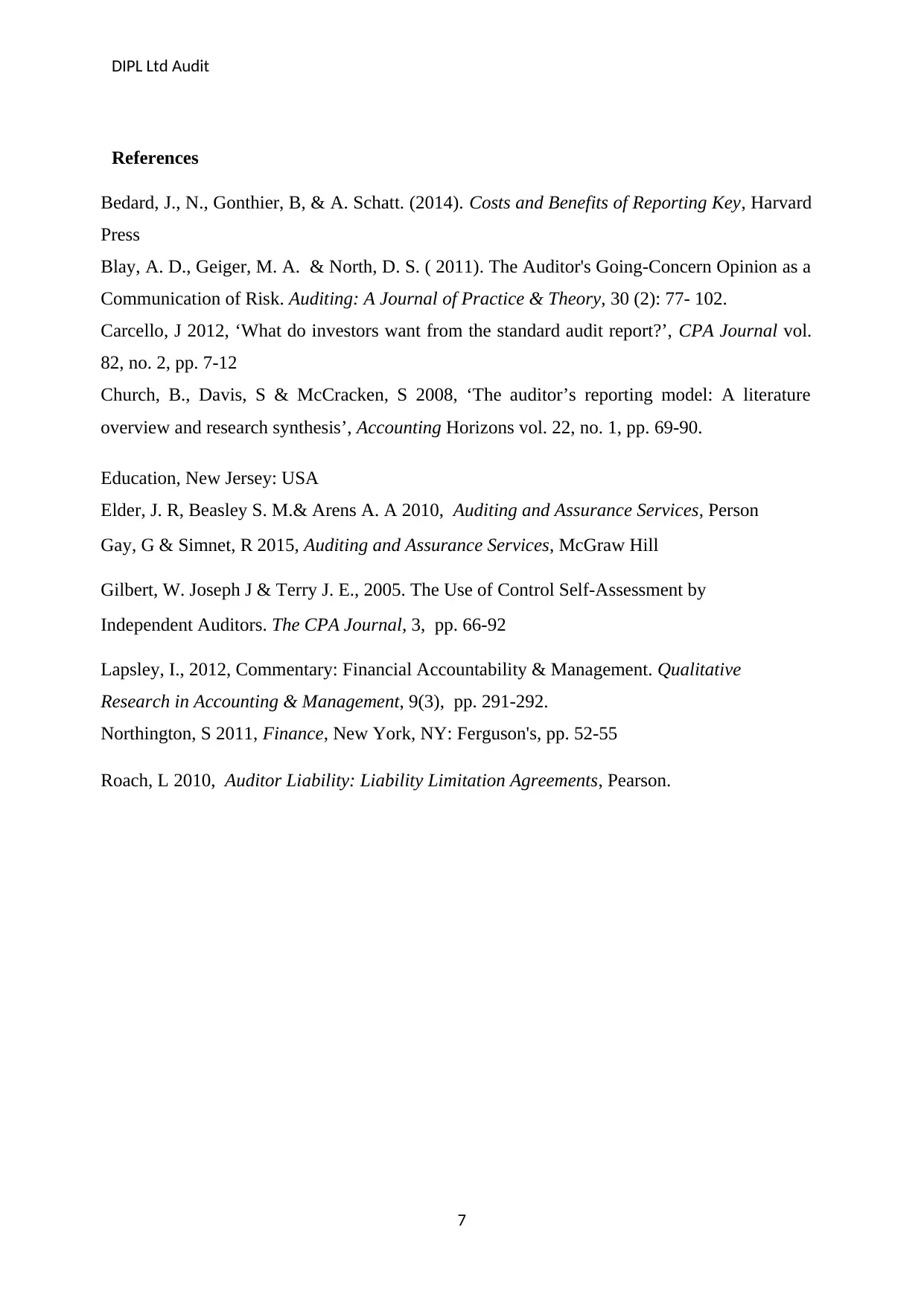
DIPL Ltd Audit
References
Bedard, J., N., Gonthier, B, & A. Schatt. (2014). Costs and Benefits of Reporting Key, Harvard
Press
Blay, A. D., Geiger, M. A. & North, D. S. ( 2011). The Auditor's Going-Concern Opinion as a
Communication of Risk. Auditing: A Journal of Practice & Theory, 30 (2): 77- 102.
Carcello, J 2012, ‘What do investors want from the standard audit report?’, CPA Journal vol.
82, no. 2, pp. 7-12
Church, B., Davis, S & McCracken, S 2008, ‘The auditor’s reporting model: A literature
overview and research synthesis’, Accounting Horizons vol. 22, no. 1, pp. 69-90.
Education, New Jersey: USA
Elder, J. R, Beasley S. M.& Arens A. A 2010, Auditing and Assurance Services, Person
Gay, G & Simnet, R 2015, Auditing and Assurance Services, McGraw Hill
Gilbert, W. Joseph J & Terry J. E., 2005. The Use of Control Self-Assessment by
Independent Auditors. The CPA Journal, 3, pp. 66-92
Lapsley, I., 2012, Commentary: Financial Accountability & Management. Qualitative
Research in Accounting & Management, 9(3), pp. 291-292.
Northington, S 2011, Finance, New York, NY: Ferguson's, pp. 52-55
Roach, L 2010, Auditor Liability: Liability Limitation Agreements, Pearson.
7
References
Bedard, J., N., Gonthier, B, & A. Schatt. (2014). Costs and Benefits of Reporting Key, Harvard
Press
Blay, A. D., Geiger, M. A. & North, D. S. ( 2011). The Auditor's Going-Concern Opinion as a
Communication of Risk. Auditing: A Journal of Practice & Theory, 30 (2): 77- 102.
Carcello, J 2012, ‘What do investors want from the standard audit report?’, CPA Journal vol.
82, no. 2, pp. 7-12
Church, B., Davis, S & McCracken, S 2008, ‘The auditor’s reporting model: A literature
overview and research synthesis’, Accounting Horizons vol. 22, no. 1, pp. 69-90.
Education, New Jersey: USA
Elder, J. R, Beasley S. M.& Arens A. A 2010, Auditing and Assurance Services, Person
Gay, G & Simnet, R 2015, Auditing and Assurance Services, McGraw Hill
Gilbert, W. Joseph J & Terry J. E., 2005. The Use of Control Self-Assessment by
Independent Auditors. The CPA Journal, 3, pp. 66-92
Lapsley, I., 2012, Commentary: Financial Accountability & Management. Qualitative
Research in Accounting & Management, 9(3), pp. 291-292.
Northington, S 2011, Finance, New York, NY: Ferguson's, pp. 52-55
Roach, L 2010, Auditor Liability: Liability Limitation Agreements, Pearson.
7
Paraphrase This Document
Need a fresh take? Get an instant paraphrase of this document with our AI Paraphraser
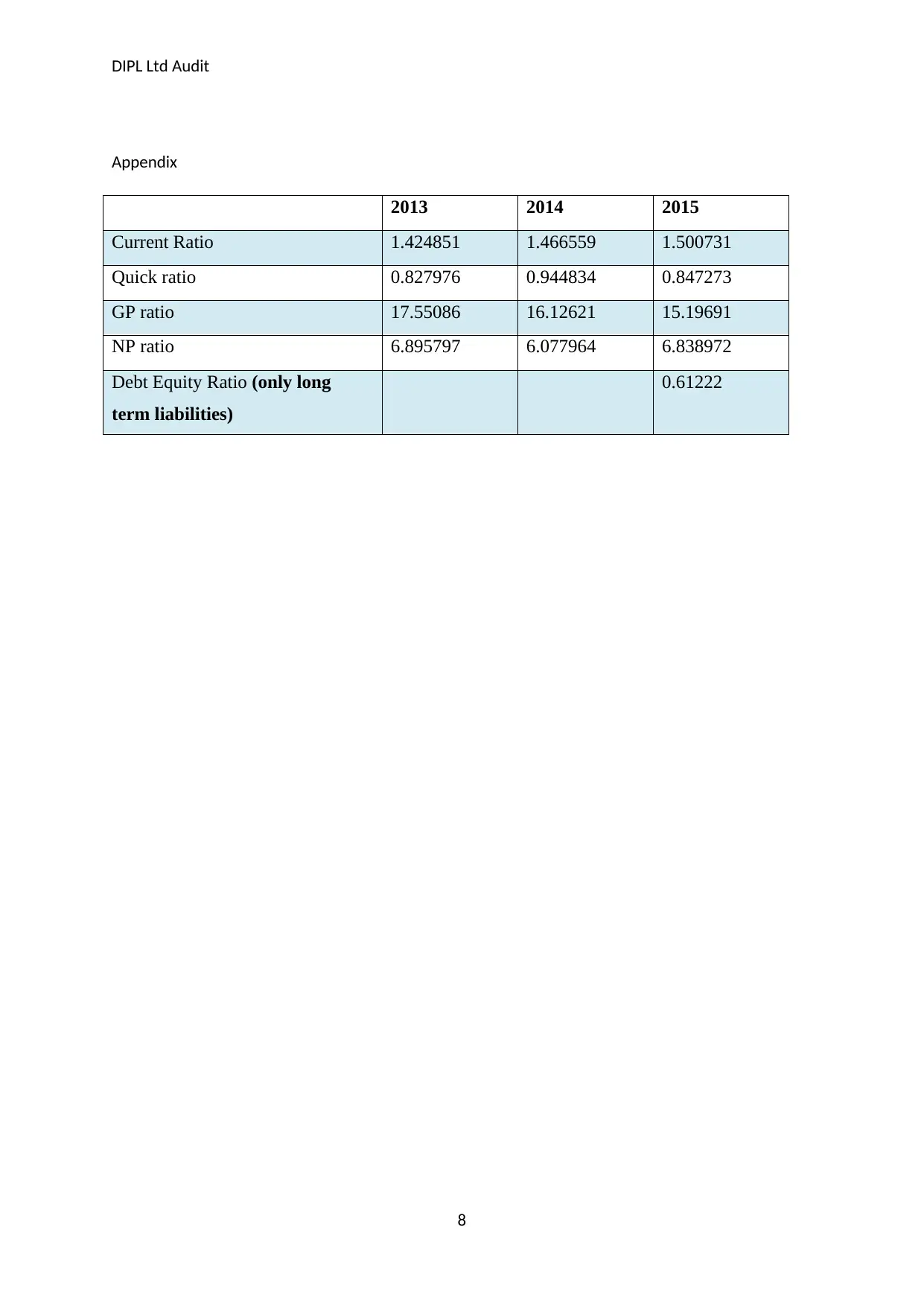
DIPL Ltd Audit
Appendix
2013 2014 2015
Current Ratio 1.424851 1.466559 1.500731
Quick ratio 0.827976 0.944834 0.847273
GP ratio 17.55086 16.12621 15.19691
NP ratio 6.895797 6.077964 6.838972
Debt Equity Ratio (only long
term liabilities)
0.61222
8
Appendix
2013 2014 2015
Current Ratio 1.424851 1.466559 1.500731
Quick ratio 0.827976 0.944834 0.847273
GP ratio 17.55086 16.12621 15.19691
NP ratio 6.895797 6.077964 6.838972
Debt Equity Ratio (only long
term liabilities)
0.61222
8
1 out of 8
Related Documents
Your All-in-One AI-Powered Toolkit for Academic Success.
+13062052269
info@desklib.com
Available 24*7 on WhatsApp / Email
![[object Object]](/_next/static/media/star-bottom.7253800d.svg)
Unlock your academic potential
Copyright © 2020–2025 A2Z Services. All Rights Reserved. Developed and managed by ZUCOL.





